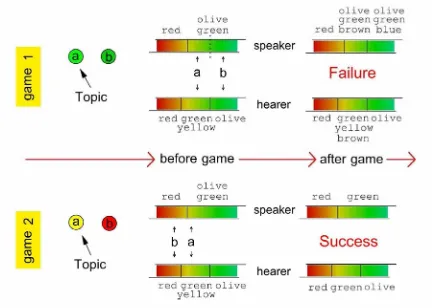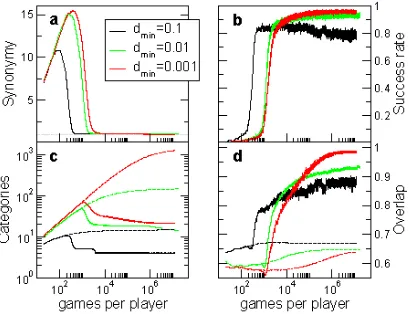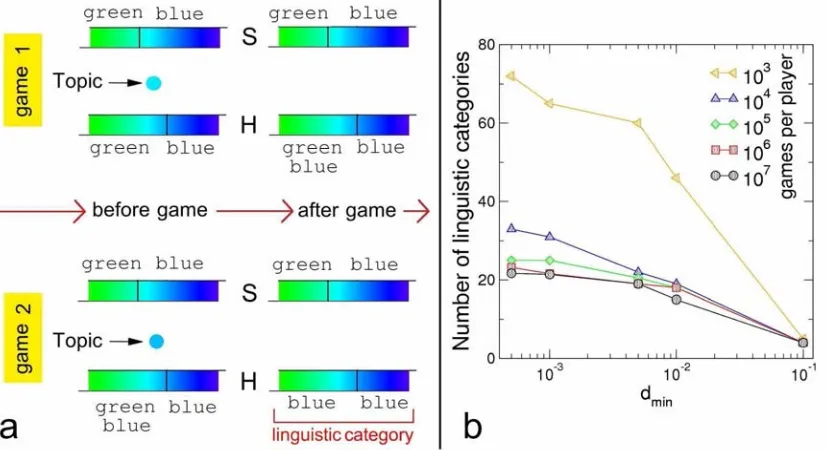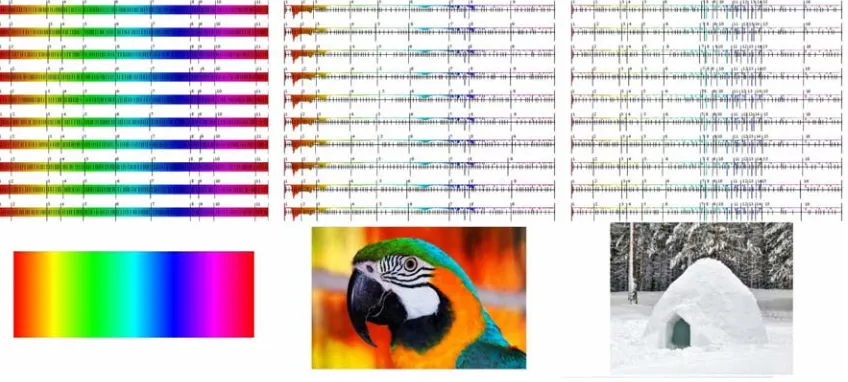City, University of London Institutional Repository
Citation
:
Puglisi, A., Baronchelli, A. and Loreto, V. (2008). Cultural route to theemergence of linguistic categories. Proceedings of the National Academy of Sciences of the United States of America (PNAS), 105(23), pp. 7936-7940. doi: 10.1073/pnas.0802485105
This is the unspecified version of the paper.
This version of the publication may differ from the final published
version.
Permanent repository link:
http://openaccess.city.ac.uk/2651/Link to published version
:
http://dx.doi.org/10.1073/pnas.0802485105Copyright and reuse:
City Research Online aims to make research
outputs of City, University of London available to a wider audience.
Copyright and Moral Rights remain with the author(s) and/or copyright
holders. URLs from City Research Online may be freely distributed and
linked to.
Cultural route to the emergence of linguistic categories
Andrea Puglisi (1), Andrea Baronchelli (1,2) & Vittorio Loreto (1)
(1)“La Sapienza” University, Physics Department, P.le A. Moro 2, 00185 Rome ITALY
(2) Departament de Física i Enginyeria Nuclear, Universitat Politècnica de Catalunya,
Campus Nord, Mòdul B4, 08034 Barcelona, Spain
Andrea.Puglisi@roma.infn.it, Andrea.Baronchelli@roma1.infn.it, Vittorio.Loreto@roma1.infn.it
Abstract
Categories provide a coarse grained description of the world. A fundamental question is whether categories simply mirror an underlying structure of nature, or instead come from the complex interactions of human beings among themselves and with the environment. Here we address this question by modelling a population of individuals who co-evolve their own system of symbols and meanings by playing elementary language games. The central result is the emergence of a hierarchical category structure made of two distinct levels: a basic layer, responsible for fine discrimination of the environment, and a shared linguistic layer that groups together perceptions to guarantee communicative success. Remarkably, the number of linguistic categories turns out to be finite and small, as observed in natural languages.
Categories are fundamental to recognize, differentiate and understand the environment.
According to Aristotle, categories are entities characterized by a set of properties which
are shared by their members [1]. A recent wave incognitive science, on the other hand,
has operated a shift in viewpoint from the object of categorization to the categorizing
subjects [2,3]: categories are culture-dependent conventions shared by a given group. In
this perspective, a crucial question is how they come to be accepted at a global level
without any central coordination [4,5,6-8]. The answer has to be found in
communication, that is the ground on which culture exerts its pressure. An established
breakthrough in language evolution [4,9-11] is the appearance of linguistic categories,
i.e. a shared repertoire of form-meaning associations in a given environment
in very different ways, but they need to align their linguistic ontologies in order to
understand each other.
In the past there have been many computational and mathematical studies
addressing the learning procedures for form-meaning associations [16-17]. From the
point of view of methodology, the evolutionary scheme, based on the maximization of
some fitness functions, has been extensively applied [18,19]. Recent years, however,
have shown that also the orthogonal approach of self-organisation can be fruitfully
exploited in multi-agent models for the emergence of language [6-8]. In this context, a
community of language users is viewed as a complex dynamical system which has to
develop a shared communication system [20,21]. In this debate, a still open problem
concerns the emergence of a small number of forms out of a diverging number of
meanings. For example the few “basic colour terms”, present in natural languages,
coarse-grain an almost infinite number of perceivable different colours [22-24].
Following this recent line of research, our work shows that an assembly of individuals
with basic communication rules and without any external supervision, may evolve an
initially empty set of categories, achieving a non-trivial communication system
characterized by a few linguistic categories. To probe the hypothesis that cultural
exchange is sufficient to this extent, individuals in our model are never replaced (as in
evolutionary schemes [18,19]), the only evolution occurring in their internal
form-meaning association tables, i.e. their “mind”. The individuals play elementary language
games [25,26] whose rules, hard-wired in individuals, constitute the only knowledge
initially shared by the population. They are also capable of perceiving analogical stimuli
and communicating with each others [6,7].
Our model involves a population of N individuals (or players), committed in
represented as a real-valued number ranging in the interval [0,1]. Here we identify
categorization as a partition of the interval [0,1] in discrete sub-intervals, from now
onwards denoted as perceptual categories [27]. Each individual has a dynamical
inventory of form-meaning associations linking perceptual categories (meanings) to
words (forms), representing their linguistic counterpart. Perceptual categories and words
associated to them co-evolve dynamically through a sequence of elementary
communication interactions, simply referred as games. All players are initialised with
only the trivial perceptual category [0,1], with no name associated to it. At each time
step a pair of individuals (one playing as speaker and the other as hearer) is selected and
presented with a new ``scene'', i.e. a set of M ≥2 objects (stimuli), denoted as
] 0,1 [
∈
i
o with i∈[1,M]. The speaker discriminates the scene and names one object and
the hearer tries to guess the named object. A correct guess makes the game successful.
Based on game's outcomes both individuals update their category boundaries and the
inventory of the associated words. A detailed description of the game is given in Fig. 1.
The perceptive resolution power of the individuals limits their ability to distinguish
objects/stimuli that are too close to each other in the perceptual space: in order to take
this into account, we define a threshold dmin, inversely proportional to their resolution
power. In a given scene the M stimuli are chosen to be at a distance larger than this
threshold, i.e.|oi −oj|>dmin for every pair (i,j). Nevertheless, objects presented in
different games may be closer than dmin . The way stimuli are randomly chosen
characterizes the kind of simulated environment: simulations will be presented both
with a homogeneous environment (uniform distribution in [0,1]) and more natural
environments (e.g., without loss of generality [27], the distributions of the hue sampled
from pictures portraying natural landscapes).
A resume of the main results of our experiments is given in Fig. 2. The evolution of the
population presents two main stages: 1) a phase where players do not understand each
other, followed by 2) a phase where communication has reached full success thanks to
the emergence of a common language, still with evolving perceptual categories. The
Fig.1: Rules of the game. A pair of examples representing a failure (game 1) and a success (game 2), respectively. In a game, two players are randomly selected from the population. Two
objects are presented to both players. The speaker selects the topic. In game 1 the speaker
has to discriminate the chosen topic (“a” in this case) by creating a new boundary in her
rightmost perceptual category at the position
(
a+b)
/2. The two new categories inherit thewords-inventory of the parent perceptual category (here the words “green” and “olive”) along with a different brand new word each (“brown” and “blue”). Then the speaker browses the list of words associated to the perceptual category containing the topic. There are two possibilities: if a previous successful communication has occurred with this category, the last winning word is chosen; otherwise the last created word is selected. In the present example the speaker chooses the word “brown”, and transmits it to the hearer. The outcome of the game is a failure since the hearer does not have the word “brown” in her inventory. The speaker unveils the topic, in a non-linguistic way (e.g. pointing at it), and the hearer adds the new word to the word
inventory of the corresponding category. In game 2 the speaker chooses the topic “a”, finds the
topic already discriminated and verbalizes it using the word “green” (which, for example, may be the winning word in the last successful communication concerning that category). The hearer knows this word and therefore points correctly to the topic. This is a successful game: both the speaker and the hearer eliminate all competing words for the perceptual category containing the topic, leaving “green” only. In general when ambiguities are present (e.g. the hearer finds the verbalized word associated to more than one category containing an object), these are solved
[image:5.595.84.516.87.395.2]the context of the ``naming game'' (an individual object to be named), has been already
studied [8], and a similar evolution was observed and explained. All individuals, when
necessary, create new words with zero probability of repetition: this leads to an initial
growth of the vocabulary associated to each perceptual category. New words are spread
through the population in later games and, whenever a word is understood by both
players, other competing words for the same category are forgotten. This eventually
leads to only one word per category. During the growth of the dictionary the success
rate, see Fig. 2b, is very small. The subsequent reduction of the dictionary corresponds
to a growing success rate which reaches its maximum value after synonymy has
disappeared. In all our numerical experiments the final success rate overcomes 80%
and in most of them goes above 90%, weakly increasing with the final number of
perceptual categories. Success is reached in a number of games per player of the order
of 5⋅102, logarithmically depending on N , and it remains constant hereafter.
The set of perceptual categories of each individual follows a somewhat different
evolution (see dashed lines in Fig. 2c). The first step of each game is, in fact, the
discrimination stage where the speaker (possibly followed by the hearer) may refine her
category inventory in order to distinguish the topic from the other objects. The growth
of the number of perceptual categories nperc of each individual is limited by the
resolution power: in a game two objects cannot appear at a distance smaller than
min
d and therefore nperc<2/dmin. The minimal distance also imposes a minimum
number of categories 1/dminthat an individual must create before her discrimination
process may stop. The average number of perceptual categories per individual, having
passed 1/dmin, grows sub-logarithmically and for many practical purposes it can be
considered constant.
The success rate is expected to depend on the alignment of the category
inventory among different individuals. The degree of alignment of category boundaries
is measured by an overlap function O (defined in the Appendix) which returns a value
proportional to the degree of alignment of the two category inventories, reaching its
Fig.2: Results of the simulations withN=100and different values of dmin:
a) Synonymy, i.e. average number of words per category; b) Success rate measured as the fraction of successful games in a sliding time windows 1000
games long; c) Average number of perceptual (dashed lines) and linguistic (solid lines) categories per individual; d) Averaged overlap, i.e. alignment among players, for perceptual (dashed curves) and linguistic (solid curves) categories.
Fig. 2d, shows that alignment grows with time and saturates to a value which is,
typically, in between 60%-70%, i.e. quite smaller than the communicative success. This
observation immediately poses a question: given such a strong misalignment among
Fig.3: Saturation in the number of linguistic categories: a) A “word contagion” phenomenon occurs whenever the topic falls in a gap between two misaligned categories of two playing individuals. In the shown examples two individuals play two successive games. In game 1 the speaker (S) says “blue” and the hearer (H), unable to understand, adds “blue” as a possible word for her leftmost category; successively (game 2) the speaker repeats “blue” and the hearer learns this word as the definitive name for that perceptual category; both left and right perceptual categories of the hearer are now identified by the same name “blue” and they can be considered (for the purpose of communication) as a single linguistic category; b) Final number of linguistic categories as a function of dmin at different times, withN=100. As the time increases the number of
linguistic categories saturates. At large times, for small dmin , the number of
linguistic categories becomes independent of dmin itself. Concerning size
dependence, only a weak (logarithmic) dependence on N, not shown, is observed.
The answer has to be found in the analysis of polysemy, i.e. the existence of perceptual
categories identified by the same unique word. Misalignment, in fact, induces a ``word
contagion'' phenomenon. With a small but non zero probability, two individuals with
similar, but not exactly equal, category boundaries, may play a game with a topic falling
[image:8.595.93.507.86.311.2]adjacent perceptual category and, through a second occurrence of a similar event, may
become the unique name of that category. Interfering events may occur in between: it is
always possible, in fact, that a game is played with a topic object falling in the bulk of
the category, where both players agree on its old name, therefore cancelling the
contagion. With respect to this cancelling probability, some gaps are too small and act
as almost perfectly aligned boundaries, drastically reducing the probability of any
further contagion. Thus, polysemy needs a two-step process to emerge, and a global
self-organised agreement to become stable. On the other hand, polysemy guarantees
communicative success: perceptual categories that are not perfectly aligned tend to have
the same name, forming true linguistic categories, much better aligned among different
individuals. The topmost curve of Fig. 2d, displays the overlap function measured
considering only boundaries between categories with different names: it is shown to
reach a much higher value, even larger than 90%.
The appearance of linguistic categories is the evidence of a coordination of the
population on a higher hierarchical level: a superior linguistic structure on top of the
individual-dependent, finer, discrimination layer. The linguistic level emerges as totally
self-organised and is the product of the (cultural) negotiation process among the
individuals. The average number of linguistic categories per individual, nling , Fig. 2c
(solid curves), grows together with ncatduring the first stage (where communicative
success is still lacking), then decreases and stabilises to a much lower value. Some
configurations of both category layers, at a time such that the success rate has overcome
95%, are presented in Fig. 4, using different sets of external stimuli.
The analysis, resumed in Fig.3b, of the dependence of nling on dmin for different
times, makes our findings robust and, to our knowledge, unprecedented. As the
resolution power is increased, i.e. as dmin is diminished, the asymptotic number of
linguistic categories becomes less and less dependent upon dmin itself. Most
importantly, even if any state with nling >1 is not stable, we have the clear evidence of
a saturation with time, in close resemblance with metastability in glassy systems
explaining the finite (and small) number of linguistic categories nling . In previous
pioneering approaches [6,7] the number of linguistic categories nling was trivially
constrained (with a small range of variability) by dmin, with a relation of the kind
min ling d
n ∝1/ , implying a divergence of nling with the resolution power. In our model
we have a clear indication of a finite nling even in the continuum limit, i.e. dmin→0,
corresponding to an infinite resolution power.
Fig.4: Categories and the pressure of environment. Inventories of 10 individuals randomly picked up in a population ofN=100players, with
0.01
=
dmin , after 7
10 games. For each player the configuration of perceptual (small vertical lines) and linguistic (long vertical lines) category boundaries is superimposed to a coloured histogram indicating the relative frequency of stimuli. The labels indicate the unique word associated to all perceptual categories forming each linguistic category. Three cases are presented: one with uniformly distributed stimuli (a) and two with stimuli randomly extracted from the hue distribution of natural pictures (b and c). One can appreciate the perfect agreement of category names, as well as the good alignment of linguistic category boundaries. Moreover, linguistic categories tend to be more refined in regions where stimuli are more frequent: an example of how the environment may influence the categorization process.
With the help of an extensive and systematic series of simulations we have shown that a
simple negotiation scheme, based on memory and feedback, is sufficient to guarantee
[image:10.595.88.512.251.442.2]objects in the world, requiring only a small set of words. Individuals alone are endowed
with the ability of forming perceptual categories, while cultural interaction among them
is responsible for the emergence and alignment of linguistic categories. Our model
reproduces a typical feature of natural languages: despite a very high resolution power,
the number of linguistic categories is very small. For instance, in many human
languages, the number of “basic colour terms” used to categorize colours usually
amounts to about ten [22-24], while the light spectrum resolution power of our eyes is
evidently much higher. Note that in our simulations we observe a reduction, with time,
of the number of linguistic categories toward the final plateau. The experimental
evidence [30], collected in empirical studies on colour categorization, of a growth of
the number of categories from simpler to more complex societies could be, in our
opinion, an effect of the increased number N of players involved in the communicative
process. Finally we believe that these results could be important both from the point of
view of language evolution theories, possibly leading to a quantitative comparison with
real data (e.g. different populations sizes and ages), and from the point view of
applications (e.g. emergence of new communication systems in biological, social and
technological contexts [31,32]).
Appendix
The degree of alignment of category boundaries is measured by the following ``overlap''
O function:
{ }
∑
i<j −ij ) N(N o = O 1
2 with
2
2 2
2 (1 )
(1 ) (1 )
j i i i i i c ij i j c c lc o lc lc − = − + −
∑
∑
∑
,where cl
lc is the width of category c, ic
ii
c is one of the categories of the i-th player, and
ij
c is the generic category of the category ``intersection'' set obtained considering all the
boundaries of both players iand j. The function oij returns a value proportional to the
degree of alignment of the two category inventories, reaching its maximum unitary
[1] J. Barnes, (Editor), The Complete Works of Aristotle: The Revised Oxford
Translation, Bollingen Series, Vol. LXXI, No. 2 (Princeton University Press, 1995).
[2] G. Lakoff, Women, Fire, and Dangerous Things (University of Chicago Press,
1987).
[3] H. Gardner, The Mind's New Science: A History of the Cognitive Revolution (Basic
Books, 1987)
[4] M. Christiansen, S. Kirby, (eds.) Language Evolution (Oxford University Press,
2005).
[5] L. Steels, In The Evolution of Language,Selected papers from 2nd International
Conference on the Evolution of Language (London, 1998).
[6] L. Steels, T. Belpaeme, Behavioral and Brain Science24, 469 (2005).
[7] T. Belpaeme, J. Bleys, Adaptive Behavior13, 293 (2005).
[8] A. Baronchelli, M Felici, E. Caglioti, V. Loreto, L. Steels, J. Stat. Mech.P06014
(2006).
[9] J. R. Hurford, M. Studdert-Kennedy, C. Knight, (eds.) Approaches to the Evolution
of Language: Social and Cognitive Bases (Cambridge University Press, 1998).
[10] M. A. Nowak, N. L. Komarova , P. Niyogi, Nature417, 611 (2002).
[11] J. Maynard-Smith, E. Szathmary, The Major Transitions in Evolution (Oxford
University Press, New York, 1997).
[12] J. R. Taylor, Linguistic Categorization: Prototypes in Linguistic Theory (Oxford
University Press, 1995).
[13] H. Coehn, C. Lefebvre, (eds.), Handbook of Categorization in Cognitive Science,
[14] G. Garrod, A. Anderson, Cognition27, 181 (1987).
[15] W. Labov, in C.-J. Bailey and R. Shuy (eds.), New Ways of Analyzing Variation in
English (Georgetown U. Press, Washington, DC, 1973).
[16] J. Hurford, Lingua77, 187 (1989).
[17] M. Oliphant, in T. Briscoe ed., Linguistic evolution through language acquisition,
(Cambridge University Press, 2002).
[18] M. A. Nowak, D. C. Krakauer, Proc. Natl. Acad. Sci. USA 98, 13189 (1999).
[19] M. A. Nowak, J. B. Plotkin, D. C. Krakauer, Jour. Theor. Bio. 200, 147 (1999).
[20] L. Steels, in M. Schoenauer (Ed.), Proceedings of PPSN VI (Springer-Verlag,
Berlin, 2000).
[21] N. L. Komarova, Frontiers of engineering: reports on leading-edge engineering
from the 2005 symposium, The National Academy Press, pp. 89-98 (2006).
[22] B. Berlin, P. Kay, Basic color terms: their universality and evolution (University of
California Press, Berkeley, 1969).
[23] D. T. Lindsey, A. M. Brown, Proc. Natl. Acad. Sci. USA 103, 16608 (2006).
[24] B. A. C. Saunders, J. van Brakel, Behavioral and Brain Sciences 20, 167 (1997).
[25] L. Wittgenstein, Philosophical Investigations (Blackwell Publisher, Malden USA,
1953).
[26] L. Steels, in C. O. Langton, K. Shimohara, (eds.)
Proceedings of Artificial Life V (MIT press, Cambridge MA, 1996).
[27] This approach can also be extended to categories with prototypes and fuzzy
boundaries, for instance adding a weight structure upon it. Typical proposals in
from the prototype [7], are exactly equivalent to our ``rigid boundaries'' categories.
Moreover, all the results of our experiment can be easily generalized to
multi-dimensional perceptual channels, provided an appropriate definition of category
domains is given. It should be kept in mind that the goal of our work is to investigate
why the continuum of perceivable meanings in the world is organized, in language, in a
finite and small number of subsets with different names, with a no immediate
(objective) cause for a given partition with respect to other infinite possibilities. Apart
from the evident example of the partition of the continuous light spectrum in a small
number of “basic color terms”, this phenomenon is widespread in language: one can
ask, for example, what objective differences allow to distinguish a cup from a glass; one
can present a multi-dimensional continuum of objects able to “contain a liquid”
(including also objects given as a prize), but a natural discontinuity between cups and
glasses does not appear; our model, even reducing the phenomenon to the case of a
1-dimensional continuum, unveils a mechanism which can be easily extended to any kind
of space, once it has been provided with a topology. The mechanism we propose for the
discrete partition in linguistic subsets (categories) does not depend on the exact nature
of this topology, which is of course a fundamental, yet different, matter of investigation.
[28] M. Mezard, G. Parisi, M. A. Virasoro, Spinglass theory and beyond (World
Scientific, New Jersey, 1987).
[29] P. G. Debenedetti, F. H. Stillinger, Nature410, 259 (2001).
[30] P. Kay, L. Maffi, American Anthropologist101, 743 (1999).
[31] L. Steels, IEEE Intelligent Systems21, 32 (2006).
Acknowledgements: The authors wish to thank C. Cattuto, G. Andrighetto, A. Baldassarri, E. Polizzi di
Sorrentino, L. Steels, T. Belpaeme, J. De Beule and B. De Vylder for many interesting discussions and
suggestions. This research has been partly supported by the EU under RD contract IST-1940 (ECAgents).



